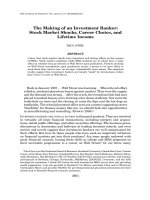- Trang chủ >>
- Khoa Học Tự Nhiên >>
- Vật lý
the making of buddhist modernism nov 2008
Bạn đang xem bản rút gọn của tài liệu. Xem và tải ngay bản đầy đủ của tài liệu tại đây (1.03 MB, 310 trang )
The Making of Buddhist
Modernism
This page intentionally left blank
The Making
of Buddhist
Modernism
david l. mcmahan
2008
3
Oxford University Press, Inc., publishes works that further
Oxford University’s objective of excellence
in research, scholarship, and education.
Oxford New York
Auckland Cape Town Dar es Salaam Hong Kong Karachi
Kuala Lumpur Madrid Melbourne Mexico City Nairobi
New Delhi Shanghai Taipei Toronto
With offi ces in
Argentina Austria Brazil Chile Czech Republic France Greece
Guatemala Hungary Italy Japan Poland Portugal Singapore
South Korea Switzerland Thailand Turkey Ukraine Vietnam
Copyright © 2008 by Oxford University Press, Inc.
Published by Oxford University Press, Inc.
198 Madison Avenue, New York, New York 10016
www.oup.com
Oxford is a registered trademark of Oxford University Press
All rights reserved. No part of this publication may be reproduced,
stored in a retrieval system, or transmitted, in any form or by any means,
electronic, mechanical, photocopying, recording, or otherwise,
without the prior permission of Oxford University Press.
Library of Congress Cataloging-in-Publication Data
McMahan, David L.
The making of Buddhist modernism / David L. McMahan.
p. cm.
Includes bibliographical references and index.
ISBN 978-0-19-518327-6
1. Buddhist modernism. 2. Buddhism—Social aspects. I. Title.
BQ316.M36 2008
294.309'051—dc22 2008014450
9 8 7 6 5 4 3 2 1
Printed in the United States of America
on acid-free paper
This project got started with a Summer Stipend from the National
Endowment for the Humanities. I am also grateful to the American
Academy of Religion for a research grant and to the Andrew W.
Mellon Foundation for a Central Pennsylvania Consortium grant.
An earlier version of chapter 4 was published as “Modernity
and the Discourse of Scientifi c Buddhism” in Journal of the Ameri-
can Academy of Religion, vol. 72, no. 4 (2004), 897-933. Portions of
this book also include material from “Demythologization and the
Core-versus-Accretions Model of Buddhism” in Indian International
Journal of Buddhism, vol. 10, no. 5 (2004), 63-99, and “Repackaging
Zen for the West” in Westward Dharma: Buddhism Beyond Asia, edited
by Charles S. Prebish and Martin Baumann, 218-229, Berkeley:
University of California Press, 2002. Thanks to the publishers for
permission to reprint this material.
Thanks also to Gerald Larson, Annette Aronowicz, Stephen
Cooper, John Lardas Modern, Jason Carbine, Charles Prebish, Paul
Numrich, Darryl Caterine, Dan Blair, Kabi Hartman, and Karen
Sattler, all of whom read portions of the manuscript or supported
the writing of this book in various ways.
Acknowledgments
This page intentionally left blank
Note on Buddhist Terminology, ix
1. Introduction: Buddhism and Modernity, 3
2. The Spectrum of Tradition and Modernism, 27
3. Buddhism and the Discourses of Modernity, 61
4. Modernity and the Discourse of Scientifi c Buddhism, 89
5. Buddhist Romanticism: Art, Spontaneity,
and the Wellsprings of Nature, 117
6. A Brief History of Interdependence, 149
7. Meditation and Modernity, 183
8. Mindfulness, Literature, and the Affi rmation of Ordinary Life, 215
9. From Modern to Postmodern?, 241
Notes, 267
Bibliography, 277
Index, 295
Contents
This page intentionally left blank
I have used Sanskrit unless referring to terms in texts in other
languages. I have italicized and included diacritical marks for non-
English terms unless they are generally familiar or are frequently
used in this book. Proper names are rendered without diacritical
marks. Sutra and sutta refer to Buddhist scriptures in Sanskrit and
Pali, respectively. Tibetan terms are generally transliterated according
to the system of Turrell Wylie; however, Tibetan terms that contain
numerous silent characters or have entered into English parlance are
rendered phonetically, with the Wylie transliteration in parentheses
with the fi rst use. Chinese terms are transliterated according to the
pinyin system. Any unattributed translations from Sanskrit or Pali
are my own.
Note on Buddhist
Terminology
This page intentionally left blank
The Making of Buddhist
Modernism
This page intentionally left blank
A New Buddhism
On a chilly Friday evening in my fi rst year of teaching at Franklin and
Marshall College, I was led at the behest of an earnest student down a
dark street to the hippest nightclub in town. Inside, ghoulish sculp-
tures protruded from fl at black walls, fl ashing lights and ear-splitting
music emanated from gyrating musicians on stage, and the dark-
ened dance fl oor writhed with pink mohawks, lip and eyebrow rings,
black leather, and torn jeans. And off to the side, sitting placidly in
a dim corner by the bar, were fi ve Tibetan Buddhist monks in their
gold and saffron robes preparing to take the stage. When the band
took a break, the monks emerged in the spotlight and, after a brief
introduction by the student, performed some guttural chanting and
a short pu¯ja¯ ceremony. Some in the young audience appeared puz-
zled but maintained a respectful silence. Others looked satisfi ed, not
understanding the Tibetan syllables or the mechanics of the ritual
but knowing that something exotic, spiritual, profound, and very cool
was happening. Afterward, a spokesperson for the local chapter of
Students for a Free Tibet briefl y discussed the Chinese occupation of
Tibet and handed out some pamphlets, and the thrashing and gyrat-
ing resumed. The monks quickly moved on to their next stop, a show
at Carnegie Hall the following evening.
It was one of the countless encounters between Buddhists and
interested westerners—characterized by overlapping interests and
1
Introduction
Buddhism and Modernity
4 the making of buddhist modernism
agendas and mutual goodwill, as well as mutual incomprehension—that for
more than a century have made up new contexts in which Buddhism can be
found and which, indeed, have constituted a new Buddhism. For the monks
and the clubgoers, life no doubt went on much as usual after this encounter.
But the event undoubtedly generated dozens of conversations among the
young partiers about the situation in Tibet, the demeanor of the monks, the
otherworldly chanting, a Free Tibet concert someone had attended, and a book
read or class taken on Buddhism. The monks surely had their conversations,
too: attempts to ascertain the signifi cance of the youths’ clothing and hair-
styles, expressions of hope that even this small event would help raise aware-
ness and support for their cause of greater autonomy for Tibet under Chinese
rule, assessments of American punk music, and perhaps comparisons of the
nightclub scene to an anteroom of a Buddhist hell realm. The conversations en-
tered the stream of discourse that makes up the growing and shifting patterns
of overlap between Buddhism and western culture.
Another of these conversations took place in my classroom the next Mon-
day, when I asked my students in an introductory class on Asian religions—our
fi rst day dealing with Buddhism—to relate some of their ideas and images of
the tradition. After the various impressions from popular fi lms and magazine
articles, someone faithfully conveyed that semester ’s version of what has be-
come a standard view: that Buddhism is a religion in which you don’t really
have to believe anything in particular or follow any strict rules; you simply ex-
ercise compassion and maintain a peaceful state of mind through meditation.
Buddhism values creativity and intuition and is basically compatible with a mod-
ern, scientifi c worldview. It is democratic, encourages freedom of thought, and
is more of a “spirituality” than a religion. While scholars steeped in the rich
diversity of Buddhism in a wide variety of cultures over its twenty-fi ve hundred
years of history—not to mention serious practitioners immersed in the com-
plexities of Buddhist practice and doctrine—may roll their eyes at such vagar-
ies, these notions are not simply a result of ignorance. They have specifi c roots
in representations of Buddhism in recent history—representations created, in
fact, by scholars and practitioners themselves. Indeed, they are accurate repre-
sentations not of Buddhism in its diverse Asian historical contexts but of a new
Buddhism that has emerged more recently.
One of the prominent shifts in the religious landscape of North America
in recent years is the explosion of Buddhism into various facets of American
culture. Buddhist monks appear in television ads and sitcoms, chant onstage at
rock concerts, and build stupas in California and upstate New York. Books on
Buddhism fi ll the bookstores, while middle-class Americans gather for informal
introduction 5
Buddhist meditation on college campuses and in Unitarian churches. What
many Americans and Europeans often understand by the term “Buddhism,”
however, is actually a modern hybrid tradition with roots in the European En-
lightenment no less than the Buddha’s enlightenment, in Romanticism and trans-
cendentalism as much as the Pali canon, and in the clash of Asian cultures and
colonial powers as much as in mindfulness and meditation. Most non-Asian
Americans tend to see Buddhism as a religion whose most important elements
are meditation, rigorous philosophical analysis, and an ethic of compassion
combined with a highly empirical psychological science that encourages reli-
ance on individual experience. It discourages blindly following authority and
dogma, has little place for superstition, magic, image worship, and gods, and is
largely compatible with the fi ndings of modern science and liberal democratic
values. While this picture draws on elements of traditional forms of Buddhism
that have existed in Asia for centuries, it is in many respects quite distinct from
what Buddhism has meant to Asian Buddhists throughout its long and varied
history. The popular western picture of Buddhism is neither unambiguously
“there” in ancient Buddhist texts and lived traditions nor merely a fantasy of
an educated elite population in the West, an image with no corresponding
object. It is, rather, an actual new form of Buddhism that is the result of a
process of modernization, westernization, reinterpretation, image-making, re-
vitalization, and reform that has been taking place not only in the West but also
in Asian countries for over a century. This new form of Buddhism has been
fashioned by modernizing Asian Buddhists and western enthusiasts deeply
engaged in creating Buddhist responses to the dominant problems and ques-
tions of modernity, such as epistemic uncertainty, religious pluralism, the
threat of nihilism, confl icts between science and religion, war, and environ-
mental destruction.
The emergence of Buddhist thought on these problems is the product of a
unique confl uence of cultures, individuals, and institutions in a time of rapid
and unprecedented transformation of societies. Many modernizing interpret-
ers of Buddhism, both Asian and western, have proffered the theme of the
rescue of the modern West—which they have claimed has lost its spiritual bear-
ings through modernization—by the humanizing wisdom of the East. In order
for the rescue to succeed, however, Buddhism itself had to be transformed,
reformed, and modernized—purged of mythological elements and “supersti-
tious” cultural accretions. Thus the Buddhism that has become visible in the
West and among urban, educated populations in Asia involves fewer rituals, de-
emphasizes the miracles and supernatural events depicted in Buddhist litera-
ture, disposes of or reinterprets image worship, and stresses compatibility with
6 the making of buddhist modernism
scientifi c, humanistic, and democratic ideals. At the same time, these recent
forms of Buddhism have not simply dispensed with all traditional elements in
an effort to accommodate to a changing world but have re-invented them.
Buddhist Modernism and the West
It is tempting to think of the various modernizing forms of Buddhism as
“Western Buddhism,” given the infl uence of western science, philosophy, and
psychology on modern variations of the dharma, as well as the visibility of
American and European authors on the subject.
1
Indeed, westerners have con-
tributed signifi cantly to transforming Buddhism in highly selective and idi-
osyncratic ways in terms of the categories, ideologies, and narratives of their
own cultures. The modernization of Buddhism, however, has in no way been
an exclusively western project or simply a representation of the eastern Other;
many fi gures essential to this process have been Asian reformers educated in
both western and Buddhist thought. Nor can the motivations of major Asian
fi gures in this process, such as Anagarika Dharmapala, Daisetz T. Suzuki, and
of late, the Fourteenth Dalai Lama, be reduced to the simple accommodation
of Buddhism to western forms of modernity. Some have infused Buddhist cat-
egories into modernist discourse only to turn around and critique modernity’s
perceived weaknesses, to resist the colonialism of the West, or to assert their
own forms of religious or national particularity. This new form of Buddhism that
I want to discuss—what some scholars have called Buddhist modernism—has
been, therefore, a cocreation of Asians, Europeans, and Americans. Although
I intend to look primarily at its manifestations in the West, such interconnec-
tions between them belie any attempt to categorize my subject as “western
Buddhism,” for it is a global phenomenon with a wide diversity of participants.
What scholars have often meant by “western Buddhism,” “American Bud-
dhism,” or “new Buddhism” is a facet of a more global network of movements
that are not the exclusive product of one geographic or cultural setting.
By “Buddhist modernism” I do not mean all Buddhism that happens to
exist in the modern era but, rather, forms of Buddhism that have emerged out
of an engagement with the dominant cultural and intellectual forces of mo-
dernity. Buddhist modernism is a dynamic, complex, and plural set of histori-
cal processes with loose bonds and fuzzy boundaries. Yet there is something
distinct enough to outline its broad contours, clarify some of its detailed
features, and trace aspects of its emergence. Heinz Bechert established the
term as a scholarly category in his Buddhismus, Staat und Gesellschaft (1966;
see also 1984). He described it as a revival movement spanning a number of
introduction 7
geographical areas and schools, a movement that reinterpreted Buddhism as
a “rational way of thought” that stressed reason, meditation, and the rediscov-
ery of canonical texts. It also deemphasized ritual, image worship, and “folk ”
beliefs and practices and was linked to social reform and nationalist move-
ments, especially in Burma and Ceylon (now Sri Lanka). In some places it
attempted to reassert Buddhism as a national religion in the face of Euro-
pean colonialism and to counter its negative colonial portrayals in west-
ern literature (1984: 276). In a later article, Bechert identifi ed a number of
key components of the early forms of Buddhist modernism. They include
demythologization—the modernization of cosmology along with a “symbolic
interpretation of traditional myths”—something that has allowed Buddhism
to be interpreted as a “scientifi c religion” over against others that stressed
belief and dogma. They also include the idea of Buddhism as a philosophy
rather than a creed or religion, the insistence on the optimism of Buddhism
(to counter early western representations of it as pessimistic) and an activist
element that stresses social work, democracy, and a “philosophy of equality.”
Also crucial is the newly central emphasis on meditation, a development that
not only has revived canonical meditation methods but also popularized and
democratized them, making them available to all at uniquely modern “medi-
tation centers” (1994: 255–56).
Richard Gombrich and Gananath Obeyesekere have mapped similar trends
specifi cally in Sinhalese Buddhism in Sri Lanka. Emphasizing the Christian in-
fl uence on modernizing forms of Sinhalese Buddhism in the late nineteenth
and twentieth centuries, as well as those of Victorian English culture, they use
the term “Protestant Buddhism” to suggest that modernizing Buddhism both
protested against European colonization and Christian missionization and
adopted elements of Protestantism. These included rejection of the clerical
links between individuals and the religious goal, emphasis on the “individu-
al’s seeking his or her ultimate goal without intermediaries,” “spiritual egali-
tarianism,” individual responsibility, and self-scrutiny. The importance placed
on the sangha (the community of monastics) was diminished as the laity
became more important.
2
Under the infl uence of Protestantism, Gombrich
and Obeyesekere assert, “religion is privatized and internalized: the truly sig-
nifi cant is not what takes place at a public celebration or in ritual, but what
happens inside one’s own mind or soul” (1988: 216). The rise of Protestant Bud-
dhism was also connected with urbanization and the rise of the bourgeoisie
in Ceylon, as well as other Asian nations, and mingled traditional Buddhist
ethics with Victorian social mores (Gombrich 1988: 172–97). It also replicated
orientalist scholars’ location of “true Buddhism” in canonical texts, while often
dismissing local or village iterations as degenerate and superstitious.
8 the making of buddhist modernism
More recently, Donald S. Lopez Jr. has mapped some of this territory in his
analysis of what he calls “modern Buddhism,” which, he contends, “stresses
equality over hierarchy, the universal over the local, and often exalts the indi-
vidual above the community” (2002: ix). It sees the Buddha’s original mes-
sage as deeply compatible with modern conceptions of “reason, empiricism,
science, universalism, individualism, tolerance, freedom and the rejection of
religious orthodoxy” (x). Modern Buddhism has much more active and visible
roles for women than its more traditional predecessors, and its social loca-
tion has often been among the educated middle classes. Lopez suggests that
modern Buddhism has developed into a kind of transnational Buddhist sect,
“an international Buddhism that transcends cultural and national boundaries,
creating . . . a cosmopolitan network of intellectuals, writing most often in
English” (xxxix). This “sect” is rooted neither in geography nor in traditional
schools but is the modern aspect of a variety of Buddhist schools in different
locations. Moreover, it has its own cosmopolitan lineage and canonical “scrip-
tures,” mainly the works of popular and semischolarly authors—fi gures from
the formative years of modern Buddhism, including So¯en Shaku, Dwight God-
dard, D. T. Suzuki, and Alexandra David-Neel, as well as more recent fi gures
like Shunryu Suzuki, Sangharakshita, Alan Watts, Thich Nhat Hanh, Chögyam
Trungpa, and the Fourteenth Dalai Lama.
These closely related conceptions of Buddhist modernism provide a fi ne
composite map of the basic territory this book will explore; but they do not
tell the whole story. It is often said as a matter of course that modernist forms
of Buddhism have been westernized, demythologized, rationalized, Romanti-
cized, Protestantized, or psychologized, yet little has been done to illuminate
the specifi c modern ideological forces, textual sources, social and cultural prac-
tices, overt philosophies, and tacit assumptions that have been involved in these
ongoing processes. In this book, I want to excavate some of the specifi c modern
western literature, concepts, ideologies, and practices that have intermingled
with Buddhism to fashion a uniquely modernist form of the dharma.
I shall try to illuminate not only how Buddhism’s encounter with moder-
nity has changed it but also how the conditions of modernity have created im-
plicit parameters for what interpretations of Buddhism become possible and
impossible. What are the nonnegotiable elements of modernity to which Bud-
dhism has conformed? What on the other hand are those aspects of moder-
nity that Buddhism challenges and attempts to transform? How has Buddhist
modernism situated itself within modern discourses of knowledge, social rela-
tions, science, and philosophy? How, in turn, have Asian Buddhists situated
the discourses of modernity within more traditional Buddhist discourses? How
has Buddhism been enlisted in preexisting concerns and debates inherent in
introduction 9
western modernity? How and why have certain elements of the Buddhist tradi-
tions been selected as serving the needs of the modern world, while others have
been ignored or suppressed? How has Buddhism fi t into the metanarratives of
American and European culture, and into those of an increasingly globalizing
modernity? How did modernizers and reformers construct Buddhist responses
to some of the issues inherent in modernity, and in doing so develop the intel-
lectual underpinnings of new forms of Buddhism both shaped by and critical
of modernity? And how have Buddhist texts, ideas, and practices come to be
understood as addressing some of the modern West ’s—as well as the modern
East ’s—deepest existential, social, and philosophical concerns? These are some
of the questions I will ask as I try to ascertain some of the ways Buddhism and
western modernity have become interfused.
Modernity and Buddhism
To comprehend the encounter between Buddhism and modernity, we must clar-
ify the multivalent term “modernity” (though, as noted, the term “Buddhism”
is not without its ambiguities as well). “Modernity” is a contested term in the
humanities and social sciences, and perhaps no one defi nition can suffi ce, nor
even one timeline. The modern state, for example, has a different history from
modern philosophy or modern economics; moreover, multiple and competing
narratives of modernity exist. It is safe to say, however, that modernity gener-
ally refers to the gradually emerging social and intellectual world rooted in the
Protestant Reformation, the scientifi c revolution, the European Enlightenment,
Romanticism, and their successors reaching up to the present. Most analysts of
modernity agree that it has produced a profound destabilization of traditional
forms, creating a dizzying onslaught of novel cultural situations. Marshall Ber-
man’s heated prose captures this sense, as well as some of the particulars of
modernity:
The maelstrom of modern life has been fed from many sources: great
discoveries in the physical sciences, changing our images of the uni-
verse and our place in it; the industrialization of production, which
transforms scientifi c knowledge into technology, creates new human
environments and destroys old ones, speeds up the whole tempo
of life, generates new forms of corporate power and class struggle;
immense demographic upheavals, severing millions of people from
their ancestral habitats, hurtling them halfway across the world into
new lives; rapid and often cataclysmic urban growth; systems of mass
10 the making of buddhist modernism
communication, dynamic in their development, enveloping and bind-
ing together the most diverse people and societies; increasingly power-
ful national states, bureaucratically structured and operated, constantly
striving to expand their powers; mass social movements of people, and
peoples, challenging their political and economic rulers, striving to
gain some control over their lives, fi nally, bearing and driving all these
people and institutions along, an ever-expanding, drastically fl uctuating
capitalist world market. In the twentieth century, the social processes
that bring this maelstrom into being and keep it in a state of perpetual
becoming, have come to be called “modernization.” (1982: 16)
Other associated factors include new forms of literature and art, the increase
and ease of global travel, and the various ideologies and rationales that have
helped create, renew, and legitimate many of these processes. The “maelstrom
of modern life” includes all of this and threatens to become so nebulous as to
be unmanageable, both in life and as an analytic category. Let us, therefore,
rein it in under some more manageable headings.
Charles Taylor ’s wide-ranging account of modernity in his vast Sources
of the Self: The Making of Modern Identity (1989) provides some vessels in which
the philosophical, religious, and social facets of the maelstrom can be con-
tained. Although he barely mentions Buddhism or Asian religions, his the-
matization of the sources of modernity provides a valuable analysis, at once
expansive and incisive, of the relevant conditions under which Buddhism en-
countered western thought and cultural practice. Without attempting to do jus-
tice to his lengthy, complex argument, throughout this work I will utilize some
of his major themes as a frame. I begin here by adopting his distillations of the
key elements of modernity into three broad domains of modern self-identity
and morality: western monotheism; rationalism and scientifi c naturalism;
and Romantic expressivism, along with their successors. Although these three
frameworks, which I will refer to as the “discourses of modernity,” are rooted
in western historical periods and forms of life, they are essential to under-
standing the development of Buddhism modernism not only in the West but
across the globe.
3
The theistic domain includes traditional concepts of God, person, and ethi-
cal obligations based primarily in Christianity. Most signifi cant to my subject
are the ongoing ramifi cations of the Protestant Reformation, missionary activ-
ity in Asia, and later, attempts at dialogue and cooperation between Buddhism
and Christianity. Asian Buddhist reformers and western interpreters and en-
thusiasts in the nineteenth and early twentieth centuries often took Christian-
ity as that to which Buddhism had to respond, either by imitation or critique
introduction 11
or both. From the scathing indictments of missionaries in Asian lands to the
emulation of Protestant anticlericism, to the contemporary Buddhist-Christian
dialogue movement, Christianity has been an ever-present source of creative
tension with modernizing Buddhism. More recently, Judaism has become im-
portant to Buddhist modernism, as Jews make up a disproportionate percent-
age of American Buddhist converts and sympathizers.
The second domain is that of scientifi c naturalism and the tradition of
rationalism rooted in the European Enlightenment. Part of the appeal of Bud-
dhism to the West, as well as its renewed prestige in Asia, has been the prospect
that Buddhism could be understood as a “rational religion” uniquely compat-
ible with modern science. This has been an important aspect of the construc-
tion of Buddhist modernism historically and remains an essential part of its
claims to legitimacy today. Yet many Buddhists have been critical of scientifi c
materialism, the technologies of warfare, the destruction of the environment,
and the hope that technology can bring about well-being. Buddhist modern-
ism has, therefore, maintained an ambivalent relationship with science, allying
itself with its basic claims on the one hand while attempting to serve as its cor-
rective on the other.
The third domain of modernity, which Taylor calls Romantic expressivism,
encompasses the literary, artistic, and philosophical movement that arose in
part as a critique of the increasing rationalization, mechanization, and desacra-
lization of the western world brought about by industrialism and the scientifi c
revolution. This movement sought to reaffi rm sacrality and mystery and to fi nd
hidden depths in nature, art, and the human soul that it claimed were increas-
ingly occluded by calculating rationality and instrumental reason. It saw nature
and feeling as sources of morality and spiritual knowledge and elevated art,
creativity, self-expression, and personal fulfi llment to virtually religious levels.
The successors of the Romantic movement were among the most important
infl uences in Buddhist modernism: the American Transcendentalists, Theoso-
phists, and adherents of other alternative spiritualities and, later, the Beat poets
and the countercultural fi gures of the 1960s. Romanticism in this broad sense
provides many themes that have become important to Buddhist modernism,
especially in the West. Romantic philosophy, art, and literature often give ex-
pression to a feeling of alienation from key features of the modern world, es-
pecially the stultifying effects of industrialism, materialistic capitalism, and
militarism. Romantics have also tended to exoticize “the East” and project the
hope that the ills of western society can be assuaged by the supposedly more
spiritual, primal wisdom of Asia. Friedrich Schiller called the Romantics “exiles
pining for a homeland,” and some in this tradition clearly saw this homeland
as the ever-distant and mysterious Other of the Orient. Echoes of Romanticism
12 the making of buddhist modernism
ring in modern Buddhist appeals to a return to the natural, to the probing of
the deep interior of consciousness, to the suspicion of external authority, to
the reveling in creative spontaneity, and to the perception of the oneness and
interconnectedness of all life.
These themes bear on the role in Buddhist modernism of what Max Weber
called the “disenchantment of the world” (a phrase Weber borrowed from
Schiller) and modern attempts at reenchantment. Weber introduced the infl u-
ential concept of disenchantment into sociology to describe modernity’s dis-
placing of traditional social orders—their ties of kinship, community, and the
natural rhythms of work and ritual—with depersonalization, oppressive rou-
tine, bureaucratic roles, and technical rules. The deities, spirits, and mysteri-
ous powers of the premodern worldview had, according to Weber, given way
to scientifi c explanation, rational calculation, and technological application. No
longer could people live in a world in which a divine order, an ethically governed
cosmos, was taken for granted. The “mechanized petrifi cation” of the workplace
and the empty glorifi cation of accumulation and wealth had displaced that world
(1958).
Weber’s account of modernity, along with its associated secularization
thesis—the idea that modernity necessarily entails the receding of religion from
public life and, for many, its disappearance altogether—has not been borne
out on a large scale. In fact, we see today a resurgence of traditional religion in
many parts of the world. Secularization and disenchantment have no doubt oc-
curred, but among limited populations, especially Europeans, the intelligentsia
of North America, and the burgeoning middle class in various Asian nations.
What is important here, though, is that regardless of whether disenchantment
has been universal, the development of Buddhist modernism has often oper-
ated on Weberian assumptions. The disenchantment of the world has been felt
among the class of people among whom are found the architects and adher-
ents of Buddhist modernism, and the dynamics of disenchantment and reen-
chantment have been important engines of its development. There is a keen
sense in the literature of Buddhist modernism that something has been lost—
an intimate connection with nature, a view of the world as vital and animate
rather than mechanistic, a peaceful harmony between human beings that has
given way to the global threat of catastrophic violence. Such literature draws
on a primitivism that has always been the shadow of rationalism, emerging
full-blown in the Romantic period, where we see a longing to slough off the
complexities of modern society, a valorization of the “noble savage,” a mod-
ern mythical being innocent of modernity’s fall into differentiation, artifi ciality,
and nihilism—someone in harmony with his environment, without the acqui-
sitiveness, the drive to power, or the spiritual vacuity of modern humanity.
introduction 13
Modernity, then, carries with it a nostalgia for the premodern and a hope that
ancient traditions can help in reenchanting the world, through, ironically, their
own kind of “sciences” and “technologies”—those of the spirit.
Closely related to disenchantment is what we might call a “crisis of mean-
ing” many have believed is endemic to modernity. A term more fashionable
among academics in the mid–twentieth century, it is yet crucial to understand-
ing my subject, for this crisis, to which some have looked to Asian religions for
solutions, arises under the unique conditions of modernity. It is different from
spiritual crises of previous cultures, which were defi ned by what Taylor calls
“inescapable frameworks” that make “imperious demands which we feel we
are unable to meet” (1989: 118). Facing permanent exile, eternal damnation, or
many unfavorable rebirths is different from facing the possibility of nihilism
that has burdened modern life, with its displacement of a taken-for-granted,
normative order of things. Even though many still live within religious frame-
works that are virtually unquestioned, modernity has always been haunted
by the specter of nihilism. Part of the way that Buddhism has engaged with
modernity is in attempting to combat the particularly modern sense of nihil-
ism and disenchantment, refashioning the dharma as a way of reenchanting
and ushering escaped meaning back into the world while at the same time re-
maining within a broadly naturalistic cosmological framework and aligning
itself with rationalistic and scientifi c sensibilities. There is, therefore, a consti-
tutive tension in Buddhist modernism—one I will return to repeatedly in this
book—between scientifi c rationalism and romantic expressivism. Buddhist
modernism, I will show, takes on much of its shape through negotiating this
tension.
Throughout each of these three discourses of modernity run themes that
constitute some of modernity’s inescapable axioms, to which any bid for inclu-
sion in the modern project must respond: individualism, egalitarianism, liber-
alism, democratic ideals, and the impulse to social reform. Two themes Taylor
stresses that run through all three discourses will be important here: fi rst, a
distinctively modern world-affi rming stance, a sense that the locus of a mean-
ingful life is not in another realm but in the way this life, everyday life, is lived,
and second, the shift toward interiority, refl exivity, and self-scrutiny. This shift
is characteristic of Enlightenment rationalism, in that truth comes to be seen
as located in the mind’s faculties of reason. Descartes’s dualism imports all
meaning to the mind itself, a move that drains all but instrumental signifi cance
from the material world. Protestantism gave unprecedented value to internal
scrutiny and to the experience of God within, while Romanticism located the
source of morality, creativity, and spirituality in the deep interior of the soul.
This inwardness of various facets of modernity became crystallized in another,
14 the making of buddhist modernism
later discourse that had an immense impact on later Buddhist modernism:
that of psychology. Beginning with Jung ’s archetypal psychoanalytic theory and
working its way up to current intertwinings of psychotherapy and mindfulness
practices, psychology would become one of the most commonly used lenses for
the interpretation of Buddhism.
Yet if we leave the question of modernity here, we risk setting up a falsely
homogeneous picture that the diversity of modernities across the globe chal-
lenges. In the classical western theories of modernity—Marx’s and Durk-
heim’s, for instance—the cultural program of modern Europe, its institutional
bases, and its dominant ideologies are destined eventually and inevitably to
spread across the globe, transforming all modernizing societies in their image.
Yet the emerging reality has been more complex and variegated. Different soci-
eties have developed diverse instantiations of modernity at different periods of
development, giving rise to an array of modernities with a variety of ideological
and institutional programs, albeit with the “original” western modernity serv-
ing as an often ambivalent reference point. The modernization of nonwestern
societies has seldom been a mere capitulation or accommodation of western
iterations of modernity but rather has combined creative, heterogeneous adap-
tation of certain aspects of modernity with selective resistance to others. Many
nonwestern cultures, moreover, have deployed particular features of moder-
nity, for example the language of human rights, in the service of resistance to
the West. Various Asian civilizations that have been colonized by European
powers, for instance, have taken up the modern, western emphases on social
protest, individual and cultural autonomy, and utopian social visions, exposing
the ironies of colonization by those who espouse human freedom and turn-
ing western discourses of emancipation back on the western colonizers.
4
Sig-
nifi cantly, the earliest forms of Buddhist modernism were in fact created in
the forges of such resistance movements. For example, nationalistic Buddhist
revival movements began in the nineteenth century in Ceylon and Japan in oppo-
sition to colonialism, Christian missionization, and western hegemony. More
recent incarnations of Buddhist modernism also negotiate this tension be-
tween adopting aspects of western modernity and critiquing them. Socially
engaged Buddhism both espouses and condemns various features of moder-
nity, for example opposing western economic imperialism and militarism
while employing western notions of women’s rights and individual freedom.
Other forms of Buddhist modernism that combine unique cultural elements
with more global trends might be considered “indigenous modernities” that
creatively entwine local or regional components of Buddhism with decidedly
modernist elements. Modernity—and Buddhist modernity—are therefore not
homogeneous.









